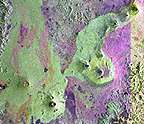

|
|
 Habitat and Diet Habitat and Diet The image to the left is a mosaic of two SIR-C images obtained by Shuttle astronauts in 1994 is presented. The original images were processed and colored (slightly differently) by Dr. Scott Madry at the Rutgers Center for Remote Sensing and Spatial Analysis. Scene is about 68 km across. North is to upper left. Habitat The image above shows the Virunga volcano chain, home to about half of the mountain gorillas remaining in the world. The pristine rainforest, shown in different shades of green in this false color image, appears as an irregular strip spanning the eight volcanoes of the chain. The forest is a small island of habitability for the gorillas surrounded by a vast sea of cleared agricultural lands, shown in light purple speckled with light green. The six volcanoes at the center and right end of the chain are dormant. The two at the left end are still very much alive, as indicated by the numerous distinct lava flows (in brown and purple) radiating from them.
Based on observations by George Schaller and others, the Virunga mountain gorillas live within the area shown on the vegetation map. Most of them live on the slopes of the three dormant volcanoes in the lower portion of the map (Karisimbi, Mikeno, and Visoke); the rest live around the three dormant volcanoes in the upper portion (Sabinyo, Mgahinga, and Muhavura). No gorillas live around the two active volcanoes (Nyamlagira and Nyiragongo). Even within the area shown on the vegetation map, the gorillas apparently never climb above about 3,965 m (13,000 ft) and are seldom seen in the low area between the two groups of dormant volcanoes. Interestingly, the gorillas also seem to avoid open meadow areas, even preferring to go around a meadow rather than cross it. The gorillas are found most frequently in the Hagenia forests, seasonally in the bamboo forests, and occasionally in the subalpine vegetation zone. Why? The most basic reason of all--food!
They also eat the fruit of several types of trees and vines, wild celery, thistles, the tender shoots of bamboo plants, and certain vines in their entirety.
For the most part, the gorillas live peacefully within the confines of the mountain forests and avoid the open, cultivated fields of the surrounding humans. Occasionally, however, mountain gorillas have been known to enter the farmers' groves to forage for bananas!
[ Biology ] [ Social Behavior ] [ Habitat & Diet ] [ Home ] [ Teacher Pages ] [ Modules & Activities ] |
HTML code by Chris Kreger
Maintained by ETE Team
Last updated April 28, 2005
Some images © 2004 www.clipart.com
Privacy Statement and Copyright © 1997-2004 by Wheeling Jesuit University/NASA-supported Classroom of the Future. All rights reserved.
Center for Educational Technologies, Circuit Board/Apple graphic logo, and COTF Classroom of the Future logo are registered trademarks of Wheeling Jesuit University.